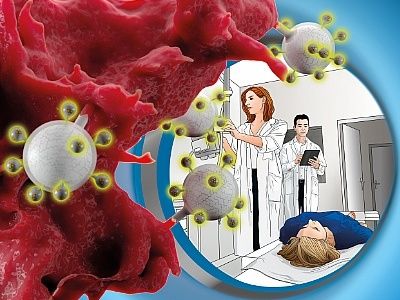Directing nanoparticles straight to tumors
Researchers trace cancer cells with tailor-made materials
Advertisement
Modern anticancer therapies aim to attack tumor cells while sparing healthy tissue. An interdisciplinary team of researchers at Helmholtz-Zentrum Dresden-Rossendorf (HZDR) and FU Berlin has made important progress in this area: the scientists have produced tiny nanoparticles that are designed to specifically target cancer cells. They can navigate directly to the tumor cells and visualize those using advanced imaging techniques. Both in petri dishes and animal models, the scientists were able to effectively guide the nanoparticles to the cancer cells. The next step is to combine the new technique with therapeutic approaches.

An interdisciplinary team has modified biocompatible nanoparticles with an antibody fragment, which binds specifically to a protein overexpressed by certain types of cancer cells. By combining the tiny particles with a diagnostic radionuclide, it is, thus, possible to detect and characterize tumor cells via PET.
HZDR / Juniks / iStockphoto, johnkellerman
The HZDR researchers start out with tiny, biocompatible nanoparticles made of so-called dendritic polyglycerols that serve as carrier molecules. “We can modify these particles and introduce various functions,” explains Dr. Kristof Zarschler, research associate at HZDR’s Institute of Radiopharmaceutical Cancer Research. “For example, we can attach an antibody fragment to the particle that specifically binds to cancer cells. This antibody fragment is our targeting moiety that directs the nanoparticle to the tumor.”
The target of the modified nanoparticles is an antigen known as EGFR (epidermal growth factor receptor). In certain types of cancer, such as breast cancer or head and neck tumors, this protein is overexpressed on the surface of the cells. “We were able to show that our designed nanoparticles preferentially interact with the cancer cells via these receptors,” confirms Dr. Holger Stephan, leader of the Nanoscalic Systems Group at HZDR. “In control tests with similar nanoparticles that had been modified with an unspecific antibody, significantly fewer nanoparticles accumulated at the tumor cells.”
The scientists intensively studied the nanoparticles’ behavior both in cell cultures and in an animal model. For this purpose, they provided the nanoparticles with additional reporter characteristics, as Kristof Zarschler explains: “We used two complementary possibilities. In addition to the antibodies, we attached dye molecules and radionuclides to the nanoparticles. The dye molecule emits in the near infrared spectrum that penetrates the tissue and can be visualized with an appropriate microscope. The dye thus reveals where exactly the nanoparticles are located.” The radionuclide, copper-64, fulfils a similar purpose. It emits radiation that is detected by a PET scanner (positron emission tomography). The signals can then be converted into a three-dimensional image that visualizes the distribution of the nanoparticles in the organism.
Excellent properties in living organisms
Using these imaging techniques, researchers have been able to show that nanoparticle accumulation in the tumor tissue reaches maximum two days after administration to mice. The labelled nanoparticles are subsequently eliminated via the kidneys without being a burden for the body. “They are apparently ideal in size and properties,” says Holger Stephan. “Smaller particles are filtered out of the blood in just a few hours and thus only have a short-term impact. If, on the other hand, the particles are too big, they accumulate in the spleen, liver or lungs and cannot be removed from the body via the kidneys and bladder.” The interplay between the nanoparticles with an exact size of three nanometers and the attached antibody fragments evidently has a positive influence on the distribution and retention of the antibody in the organism as well as on its excretion profile.
In future experiments, the HZDR researchers want to test whether they can modify their system to carry other components. Kristof Zarschler describes the plans: “You can take these nanoparticles and functionalize them with an active substance. Then you can deliver a drug directly to the tumor. This might be a therapeutic radionuclide that destroys the tumor cells.” It is also possible to attach antibody fragments specific for proteins other than EGFR to target different types of cancer.




















































